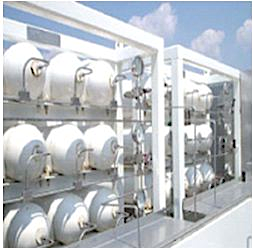Storage & Use
Hydrogen should be stored outside at a safe distance from structures, ventilation intakes, and vehicle routes. Separation distance requirements are typically based on leak rate potential and vary depending on storage volume and pressure as well as pipe diameter. Consult NFPA 2 for specific distance requirements.
When hydrogen is used indoors, the best practice is to store the hydrogen outdoors and transfer the hydrogen to the indoor users using welded piping.
Compressed gas is typically stored in cylinders or pressure vessels designed for the high-pressure gas. Liquid hydrogen is usually stored in vacuum-insulated cylindrical tanks at relatively low pressures.
Outside Cylinder Storage
(Photo courtesy of Pacific Northwest National Laboratory)
Bulk hydrogen storage systems typically include:
- Storage containers
- Heat exchangers (for liquid systems)
- Compressors
- Pressure regulators
- Pressure relief devices
- Connecting piping
Hydrogen Gas Storage Vessels
(Photo courtesy of Shell Hydrogen)
If a hydrogen cylinder is placed indoors, additional safety considerations must be addressed:
- Limiting total hydrogen volume based on workspace size
- Maintaining minimum spacing between cylinders of hydrogen and oxidants
- Securing cylinders
Safety considerations for the indoor use of hydrogen include:
- Buildings should be constructed of noncombustible materials.
- Mechanical ventilation systems should introduce air low to the floor and exhaust at the highest point of the room. Consideration should be given to provide ventilation for both normal conditions and emergency situations.
- Hydrogen sensors should be installed.
- Hydrogen flow should be automatically shut off when a leak or fire is detected.
- Ignition sources should be eliminated by precautions such as the use of classified electrical equipment.
- Hydrogen system components should be electrically bonded and grounded.
When hydrogen cylinders are stored outdoors with weather protection such as a shed, the same considerations (e.g., noncombustible construction and ventilation) that apply to indoor use of hydrogen apply to the weather protection structure. See NFPA 2 for guidance.
References
CGA PS-21, CGA Position Statement on Adjacent Storage of Compressed Hydrogen and Other Flammable Gases
G-095, ANSI/AIAA Guide to Safety of Hydrogen and Hydrogen Systems
NFPA 55, Standard for the Storage, Use, and Handling of Compressed Gases and Cryogenic Fluids in Portable and Stationary Containers, Cylinders, and Tanks
See OSHA standard 29 CFR 1910.103 for regulations on separation distances for hydrogen storage facilities.



